Evaluating Global Market Influences on Organization's Structure
VerifiedAdded on 2020/11/30
|6
|2091
|148
Report
AI Summary
This report examines the profound impact of the global market on organizational structure, culture, and functions. It employs the McKinsey 7S model to assess the interconnectedness of structure, strategy, systems, style, staff, skills, and shared values within a global context. Furthermore, the report utilizes Porter's Five Forces to analyze the competitive landscape, including threats of new entry, threats of substitutes, supplier power, buyer power, and competitive rivalry. The analysis extends to evaluating ethical and sustainable globalization influences on organizational functions and exploring effective decision-making processes in a global setting. Additionally, the report identifies various routes to internationalization and discusses potential barriers organizations may encounter. The report integrates academic sources to support its analysis.
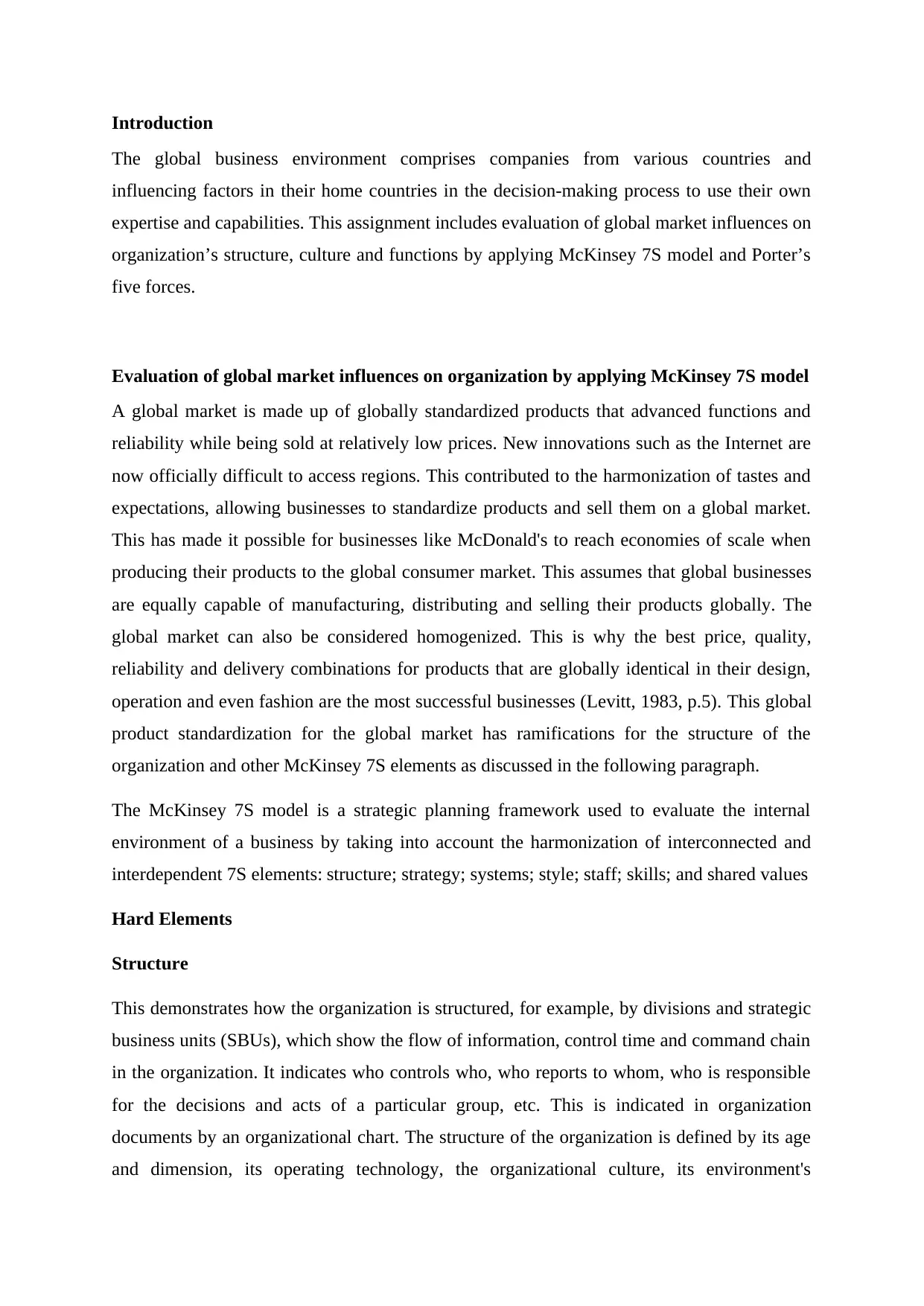
Introduction
The global business environment comprises companies from various countries and
influencing factors in their home countries in the decision-making process to use their own
expertise and capabilities. This assignment includes evaluation of global market influences on
organization’s structure, culture and functions by applying McKinsey 7S model and Porter’s
five forces.
Evaluation of global market influences on organization by applying McKinsey 7S model
A global market is made up of globally standardized products that advanced functions and
reliability while being sold at relatively low prices. New innovations such as the Internet are
now officially difficult to access regions. This contributed to the harmonization of tastes and
expectations, allowing businesses to standardize products and sell them on a global market.
This has made it possible for businesses like McDonald's to reach economies of scale when
producing their products to the global consumer market. This assumes that global businesses
are equally capable of manufacturing, distributing and selling their products globally. The
global market can also be considered homogenized. This is why the best price, quality,
reliability and delivery combinations for products that are globally identical in their design,
operation and even fashion are the most successful businesses (Levitt, 1983, p.5). This global
product standardization for the global market has ramifications for the structure of the
organization and other McKinsey 7S elements as discussed in the following paragraph.
The McKinsey 7S model is a strategic planning framework used to evaluate the internal
environment of a business by taking into account the harmonization of interconnected and
interdependent 7S elements: structure; strategy; systems; style; staff; skills; and shared values
Hard Elements
Structure
This demonstrates how the organization is structured, for example, by divisions and strategic
business units (SBUs), which show the flow of information, control time and command chain
in the organization. It indicates who controls who, who reports to whom, who is responsible
for the decisions and acts of a particular group, etc. This is indicated in organization
documents by an organizational chart. The structure of the organization is defined by its age
and dimension, its operating technology, the organizational culture, its environment's
The global business environment comprises companies from various countries and
influencing factors in their home countries in the decision-making process to use their own
expertise and capabilities. This assignment includes evaluation of global market influences on
organization’s structure, culture and functions by applying McKinsey 7S model and Porter’s
five forces.
Evaluation of global market influences on organization by applying McKinsey 7S model
A global market is made up of globally standardized products that advanced functions and
reliability while being sold at relatively low prices. New innovations such as the Internet are
now officially difficult to access regions. This contributed to the harmonization of tastes and
expectations, allowing businesses to standardize products and sell them on a global market.
This has made it possible for businesses like McDonald's to reach economies of scale when
producing their products to the global consumer market. This assumes that global businesses
are equally capable of manufacturing, distributing and selling their products globally. The
global market can also be considered homogenized. This is why the best price, quality,
reliability and delivery combinations for products that are globally identical in their design,
operation and even fashion are the most successful businesses (Levitt, 1983, p.5). This global
product standardization for the global market has ramifications for the structure of the
organization and other McKinsey 7S elements as discussed in the following paragraph.
The McKinsey 7S model is a strategic planning framework used to evaluate the internal
environment of a business by taking into account the harmonization of interconnected and
interdependent 7S elements: structure; strategy; systems; style; staff; skills; and shared values
Hard Elements
Structure
This demonstrates how the organization is structured, for example, by divisions and strategic
business units (SBUs), which show the flow of information, control time and command chain
in the organization. It indicates who controls who, who reports to whom, who is responsible
for the decisions and acts of a particular group, etc. This is indicated in organization
documents by an organizational chart. The structure of the organization is defined by its age
and dimension, its operating technology, the organizational culture, its environment's
Paraphrase This Document
Need a fresh take? Get an instant paraphrase of this document with our AI Paraphraser
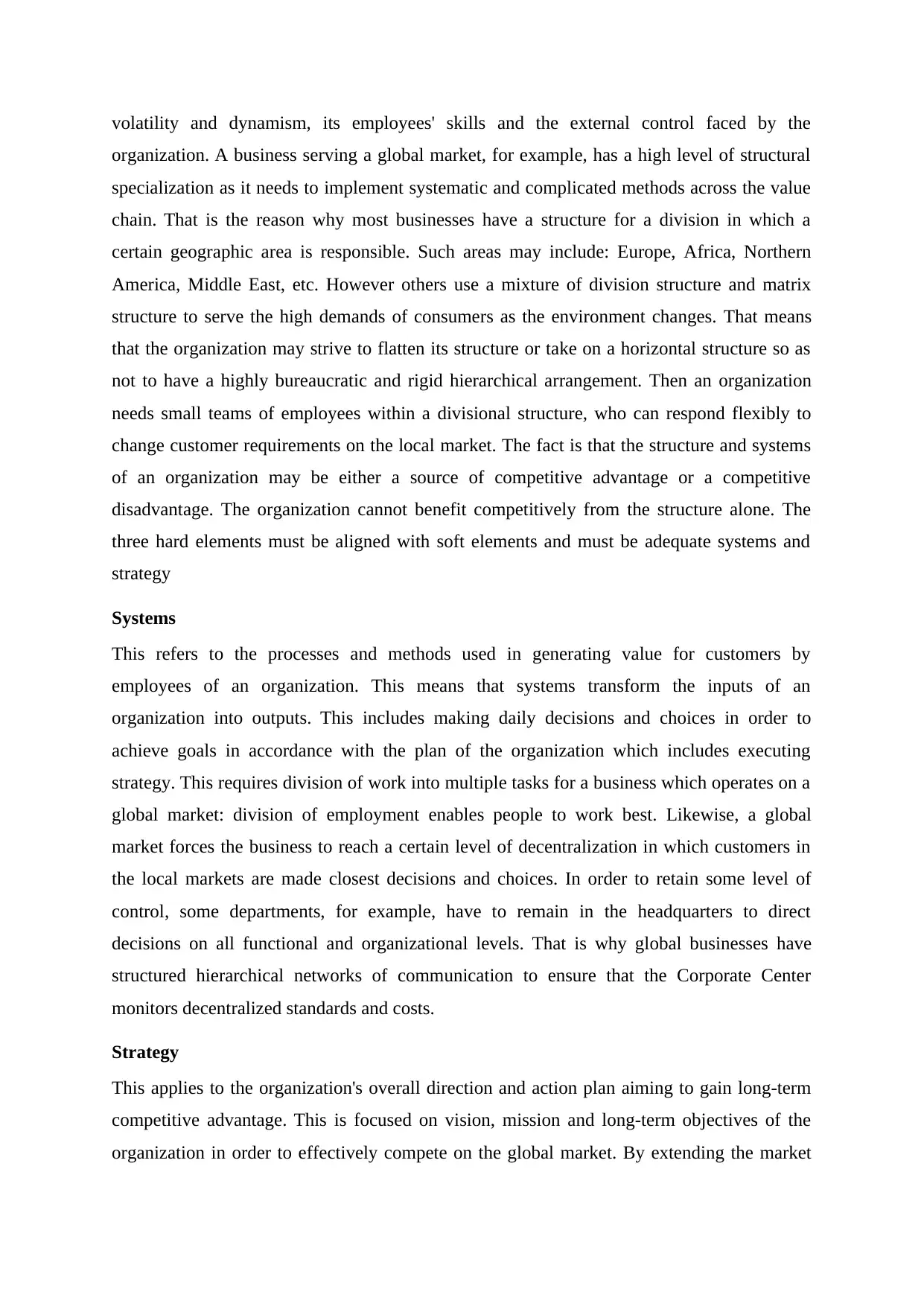
volatility and dynamism, its employees' skills and the external control faced by the
organization. A business serving a global market, for example, has a high level of structural
specialization as it needs to implement systematic and complicated methods across the value
chain. That is the reason why most businesses have a structure for a division in which a
certain geographic area is responsible. Such areas may include: Europe, Africa, Northern
America, Middle East, etc. However others use a mixture of division structure and matrix
structure to serve the high demands of consumers as the environment changes. That means
that the organization may strive to flatten its structure or take on a horizontal structure so as
not to have a highly bureaucratic and rigid hierarchical arrangement. Then an organization
needs small teams of employees within a divisional structure, who can respond flexibly to
change customer requirements on the local market. The fact is that the structure and systems
of an organization may be either a source of competitive advantage or a competitive
disadvantage. The organization cannot benefit competitively from the structure alone. The
three hard elements must be aligned with soft elements and must be adequate systems and
strategy
Systems
This refers to the processes and methods used in generating value for customers by
employees of an organization. This means that systems transform the inputs of an
organization into outputs. This includes making daily decisions and choices in order to
achieve goals in accordance with the plan of the organization which includes executing
strategy. This requires division of work into multiple tasks for a business which operates on a
global market: division of employment enables people to work best. Likewise, a global
market forces the business to reach a certain level of decentralization in which customers in
the local markets are made closest decisions and choices. In order to retain some level of
control, some departments, for example, have to remain in the headquarters to direct
decisions on all functional and organizational levels. That is why global businesses have
structured hierarchical networks of communication to ensure that the Corporate Center
monitors decentralized standards and costs.
Strategy
This applies to the organization's overall direction and action plan aiming to gain long-term
competitive advantage. This is focused on vision, mission and long-term objectives of the
organization in order to effectively compete on the global market. By extending the market
organization. A business serving a global market, for example, has a high level of structural
specialization as it needs to implement systematic and complicated methods across the value
chain. That is the reason why most businesses have a structure for a division in which a
certain geographic area is responsible. Such areas may include: Europe, Africa, Northern
America, Middle East, etc. However others use a mixture of division structure and matrix
structure to serve the high demands of consumers as the environment changes. That means
that the organization may strive to flatten its structure or take on a horizontal structure so as
not to have a highly bureaucratic and rigid hierarchical arrangement. Then an organization
needs small teams of employees within a divisional structure, who can respond flexibly to
change customer requirements on the local market. The fact is that the structure and systems
of an organization may be either a source of competitive advantage or a competitive
disadvantage. The organization cannot benefit competitively from the structure alone. The
three hard elements must be aligned with soft elements and must be adequate systems and
strategy
Systems
This refers to the processes and methods used in generating value for customers by
employees of an organization. This means that systems transform the inputs of an
organization into outputs. This includes making daily decisions and choices in order to
achieve goals in accordance with the plan of the organization which includes executing
strategy. This requires division of work into multiple tasks for a business which operates on a
global market: division of employment enables people to work best. Likewise, a global
market forces the business to reach a certain level of decentralization in which customers in
the local markets are made closest decisions and choices. In order to retain some level of
control, some departments, for example, have to remain in the headquarters to direct
decisions on all functional and organizational levels. That is why global businesses have
structured hierarchical networks of communication to ensure that the Corporate Center
monitors decentralized standards and costs.
Strategy
This applies to the organization's overall direction and action plan aiming to gain long-term
competitive advantage. This is focused on vision, mission and long-term objectives of the
organization in order to effectively compete on the global market. By extending the market
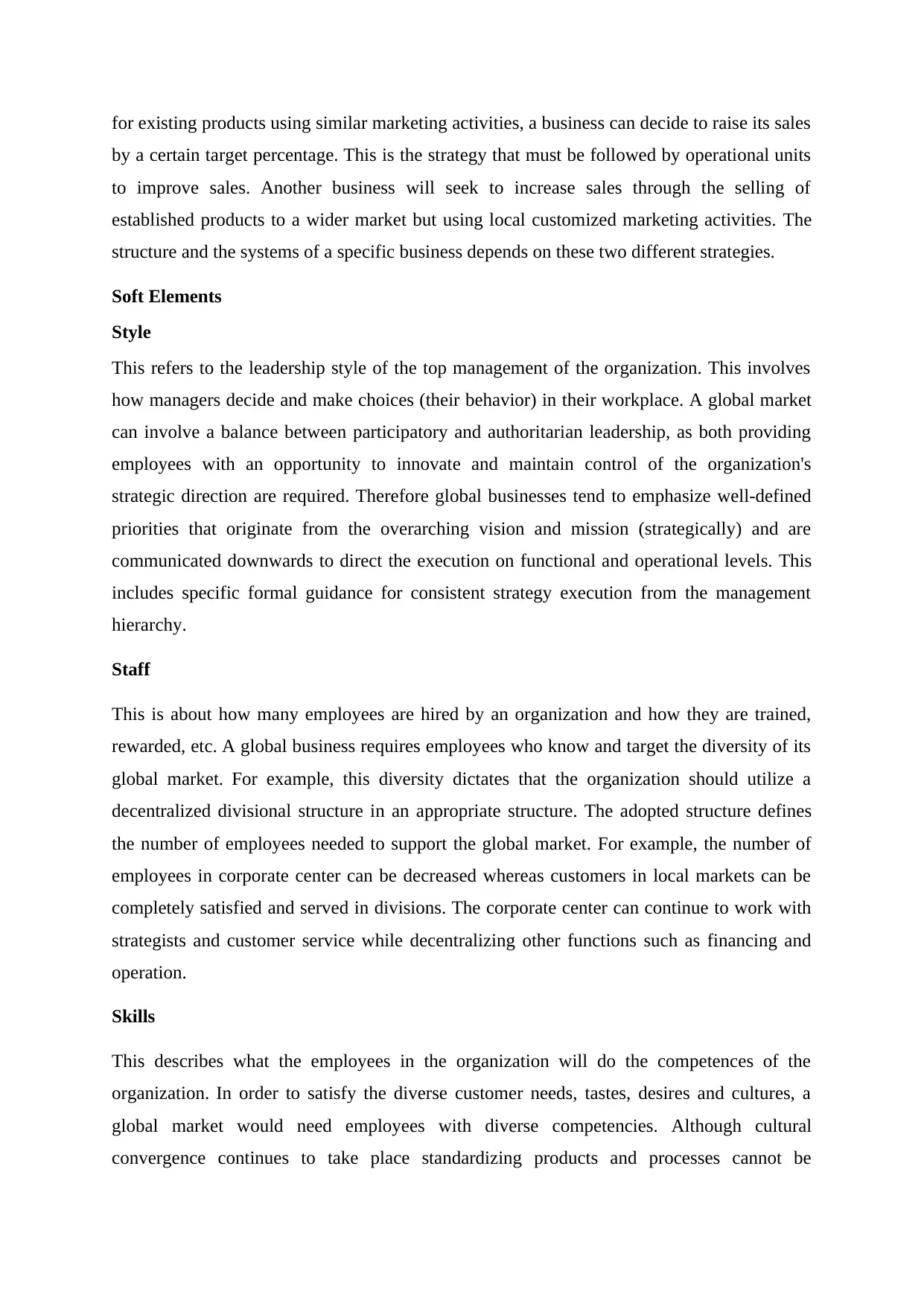
for existing products using similar marketing activities, a business can decide to raise its sales
by a certain target percentage. This is the strategy that must be followed by operational units
to improve sales. Another business will seek to increase sales through the selling of
established products to a wider market but using local customized marketing activities. The
structure and the systems of a specific business depends on these two different strategies.
Soft Elements
Style
This refers to the leadership style of the top management of the organization. This involves
how managers decide and make choices (their behavior) in their workplace. A global market
can involve a balance between participatory and authoritarian leadership, as both providing
employees with an opportunity to innovate and maintain control of the organization's
strategic direction are required. Therefore global businesses tend to emphasize well-defined
priorities that originate from the overarching vision and mission (strategically) and are
communicated downwards to direct the execution on functional and operational levels. This
includes specific formal guidance for consistent strategy execution from the management
hierarchy.
Staff
This is about how many employees are hired by an organization and how they are trained,
rewarded, etc. A global business requires employees who know and target the diversity of its
global market. For example, this diversity dictates that the organization should utilize a
decentralized divisional structure in an appropriate structure. The adopted structure defines
the number of employees needed to support the global market. For example, the number of
employees in corporate center can be decreased whereas customers in local markets can be
completely satisfied and served in divisions. The corporate center can continue to work with
strategists and customer service while decentralizing other functions such as financing and
operation.
Skills
This describes what the employees in the organization will do the competences of the
organization. In order to satisfy the diverse customer needs, tastes, desires and cultures, a
global market would need employees with diverse competencies. Although cultural
convergence continues to take place standardizing products and processes cannot be
by a certain target percentage. This is the strategy that must be followed by operational units
to improve sales. Another business will seek to increase sales through the selling of
established products to a wider market but using local customized marketing activities. The
structure and the systems of a specific business depends on these two different strategies.
Soft Elements
Style
This refers to the leadership style of the top management of the organization. This involves
how managers decide and make choices (their behavior) in their workplace. A global market
can involve a balance between participatory and authoritarian leadership, as both providing
employees with an opportunity to innovate and maintain control of the organization's
strategic direction are required. Therefore global businesses tend to emphasize well-defined
priorities that originate from the overarching vision and mission (strategically) and are
communicated downwards to direct the execution on functional and operational levels. This
includes specific formal guidance for consistent strategy execution from the management
hierarchy.
Staff
This is about how many employees are hired by an organization and how they are trained,
rewarded, etc. A global business requires employees who know and target the diversity of its
global market. For example, this diversity dictates that the organization should utilize a
decentralized divisional structure in an appropriate structure. The adopted structure defines
the number of employees needed to support the global market. For example, the number of
employees in corporate center can be decreased whereas customers in local markets can be
completely satisfied and served in divisions. The corporate center can continue to work with
strategists and customer service while decentralizing other functions such as financing and
operation.
Skills
This describes what the employees in the organization will do the competences of the
organization. In order to satisfy the diverse customer needs, tastes, desires and cultures, a
global market would need employees with diverse competencies. Although cultural
convergence continues to take place standardizing products and processes cannot be
⊘ This is a preview!⊘
Do you want full access?
Subscribe today to unlock all pages.

Trusted by 1+ million students worldwide
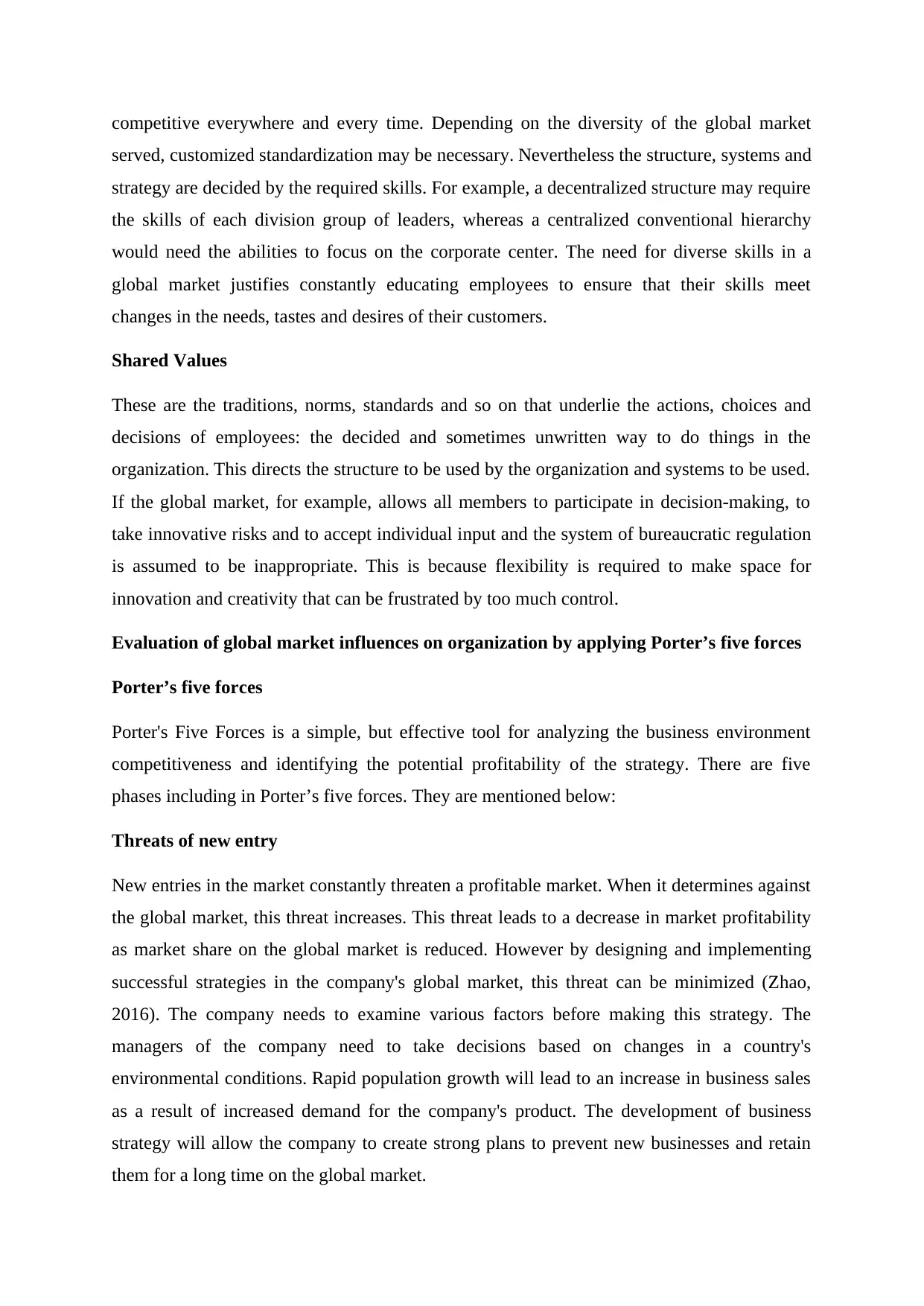
competitive everywhere and every time. Depending on the diversity of the global market
served, customized standardization may be necessary. Nevertheless the structure, systems and
strategy are decided by the required skills. For example, a decentralized structure may require
the skills of each division group of leaders, whereas a centralized conventional hierarchy
would need the abilities to focus on the corporate center. The need for diverse skills in a
global market justifies constantly educating employees to ensure that their skills meet
changes in the needs, tastes and desires of their customers.
Shared Values
These are the traditions, norms, standards and so on that underlie the actions, choices and
decisions of employees: the decided and sometimes unwritten way to do things in the
organization. This directs the structure to be used by the organization and systems to be used.
If the global market, for example, allows all members to participate in decision-making, to
take innovative risks and to accept individual input and the system of bureaucratic regulation
is assumed to be inappropriate. This is because flexibility is required to make space for
innovation and creativity that can be frustrated by too much control.
Evaluation of global market influences on organization by applying Porter’s five forces
Porter’s five forces
Porter's Five Forces is a simple, but effective tool for analyzing the business environment
competitiveness and identifying the potential profitability of the strategy. There are five
phases including in Porter’s five forces. They are mentioned below:
Threats of new entry
New entries in the market constantly threaten a profitable market. When it determines against
the global market, this threat increases. This threat leads to a decrease in market profitability
as market share on the global market is reduced. However by designing and implementing
successful strategies in the company's global market, this threat can be minimized (Zhao,
2016). The company needs to examine various factors before making this strategy. The
managers of the company need to take decisions based on changes in a country's
environmental conditions. Rapid population growth will lead to an increase in business sales
as a result of increased demand for the company's product. The development of business
strategy will allow the company to create strong plans to prevent new businesses and retain
them for a long time on the global market.
served, customized standardization may be necessary. Nevertheless the structure, systems and
strategy are decided by the required skills. For example, a decentralized structure may require
the skills of each division group of leaders, whereas a centralized conventional hierarchy
would need the abilities to focus on the corporate center. The need for diverse skills in a
global market justifies constantly educating employees to ensure that their skills meet
changes in the needs, tastes and desires of their customers.
Shared Values
These are the traditions, norms, standards and so on that underlie the actions, choices and
decisions of employees: the decided and sometimes unwritten way to do things in the
organization. This directs the structure to be used by the organization and systems to be used.
If the global market, for example, allows all members to participate in decision-making, to
take innovative risks and to accept individual input and the system of bureaucratic regulation
is assumed to be inappropriate. This is because flexibility is required to make space for
innovation and creativity that can be frustrated by too much control.
Evaluation of global market influences on organization by applying Porter’s five forces
Porter’s five forces
Porter's Five Forces is a simple, but effective tool for analyzing the business environment
competitiveness and identifying the potential profitability of the strategy. There are five
phases including in Porter’s five forces. They are mentioned below:
Threats of new entry
New entries in the market constantly threaten a profitable market. When it determines against
the global market, this threat increases. This threat leads to a decrease in market profitability
as market share on the global market is reduced. However by designing and implementing
successful strategies in the company's global market, this threat can be minimized (Zhao,
2016). The company needs to examine various factors before making this strategy. The
managers of the company need to take decisions based on changes in a country's
environmental conditions. Rapid population growth will lead to an increase in business sales
as a result of increased demand for the company's product. The development of business
strategy will allow the company to create strong plans to prevent new businesses and retain
them for a long time on the global market.
Paraphrase This Document
Need a fresh take? Get an instant paraphrase of this document with our AI Paraphraser
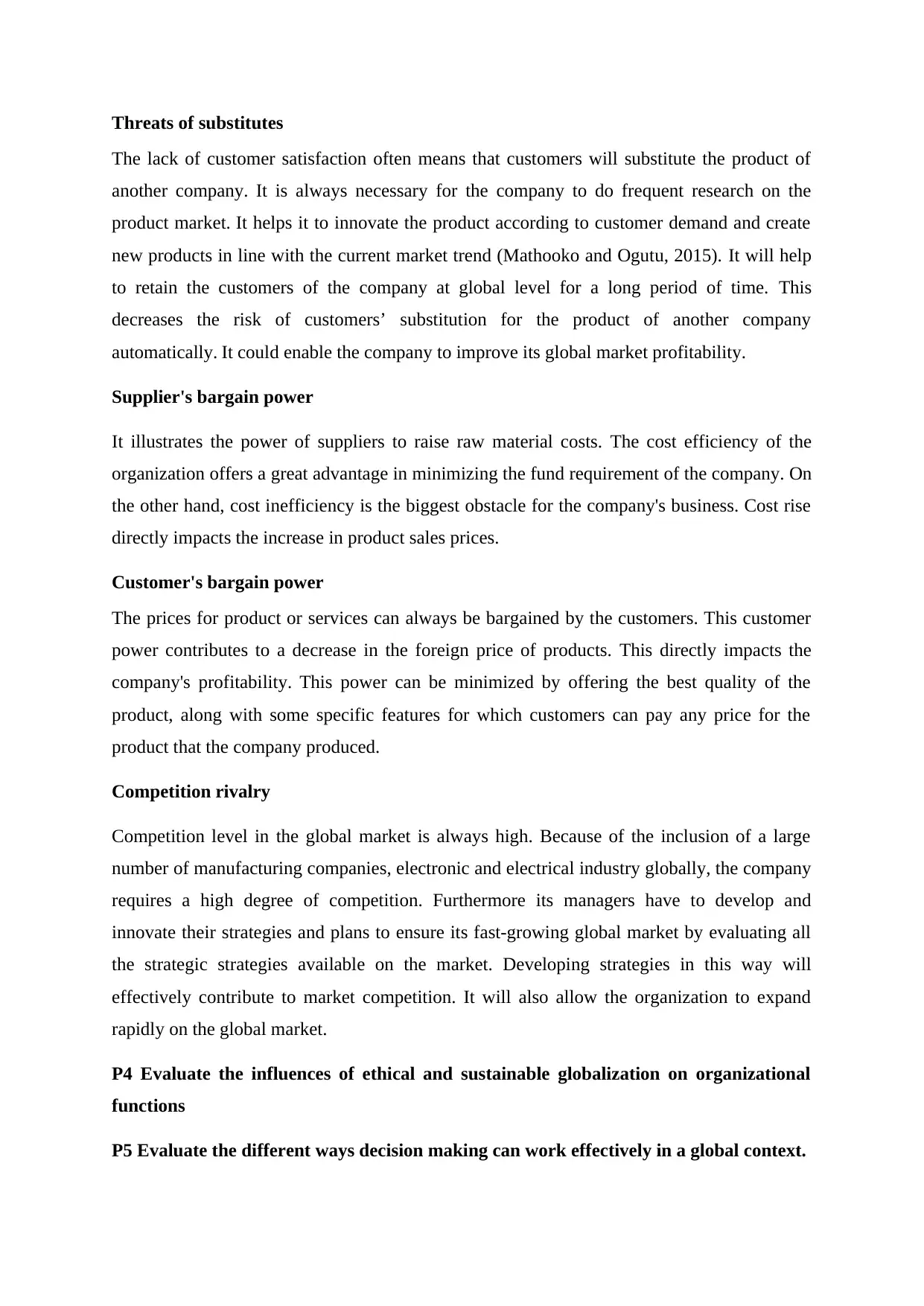
Threats of substitutes
The lack of customer satisfaction often means that customers will substitute the product of
another company. It is always necessary for the company to do frequent research on the
product market. It helps it to innovate the product according to customer demand and create
new products in line with the current market trend (Mathooko and Ogutu, 2015). It will help
to retain the customers of the company at global level for a long period of time. This
decreases the risk of customers’ substitution for the product of another company
automatically. It could enable the company to improve its global market profitability.
Supplier's bargain power
It illustrates the power of suppliers to raise raw material costs. The cost efficiency of the
organization offers a great advantage in minimizing the fund requirement of the company. On
the other hand, cost inefficiency is the biggest obstacle for the company's business. Cost rise
directly impacts the increase in product sales prices.
Customer's bargain power
The prices for product or services can always be bargained by the customers. This customer
power contributes to a decrease in the foreign price of products. This directly impacts the
company's profitability. This power can be minimized by offering the best quality of the
product, along with some specific features for which customers can pay any price for the
product that the company produced.
Competition rivalry
Competition level in the global market is always high. Because of the inclusion of a large
number of manufacturing companies, electronic and electrical industry globally, the company
requires a high degree of competition. Furthermore its managers have to develop and
innovate their strategies and plans to ensure its fast-growing global market by evaluating all
the strategic strategies available on the market. Developing strategies in this way will
effectively contribute to market competition. It will also allow the organization to expand
rapidly on the global market.
P4 Evaluate the influences of ethical and sustainable globalization on organizational
functions
P5 Evaluate the different ways decision making can work effectively in a global context.
The lack of customer satisfaction often means that customers will substitute the product of
another company. It is always necessary for the company to do frequent research on the
product market. It helps it to innovate the product according to customer demand and create
new products in line with the current market trend (Mathooko and Ogutu, 2015). It will help
to retain the customers of the company at global level for a long period of time. This
decreases the risk of customers’ substitution for the product of another company
automatically. It could enable the company to improve its global market profitability.
Supplier's bargain power
It illustrates the power of suppliers to raise raw material costs. The cost efficiency of the
organization offers a great advantage in minimizing the fund requirement of the company. On
the other hand, cost inefficiency is the biggest obstacle for the company's business. Cost rise
directly impacts the increase in product sales prices.
Customer's bargain power
The prices for product or services can always be bargained by the customers. This customer
power contributes to a decrease in the foreign price of products. This directly impacts the
company's profitability. This power can be minimized by offering the best quality of the
product, along with some specific features for which customers can pay any price for the
product that the company produced.
Competition rivalry
Competition level in the global market is always high. Because of the inclusion of a large
number of manufacturing companies, electronic and electrical industry globally, the company
requires a high degree of competition. Furthermore its managers have to develop and
innovate their strategies and plans to ensure its fast-growing global market by evaluating all
the strategic strategies available on the market. Developing strategies in this way will
effectively contribute to market competition. It will also allow the organization to expand
rapidly on the global market.
P4 Evaluate the influences of ethical and sustainable globalization on organizational
functions
P5 Evaluate the different ways decision making can work effectively in a global context.
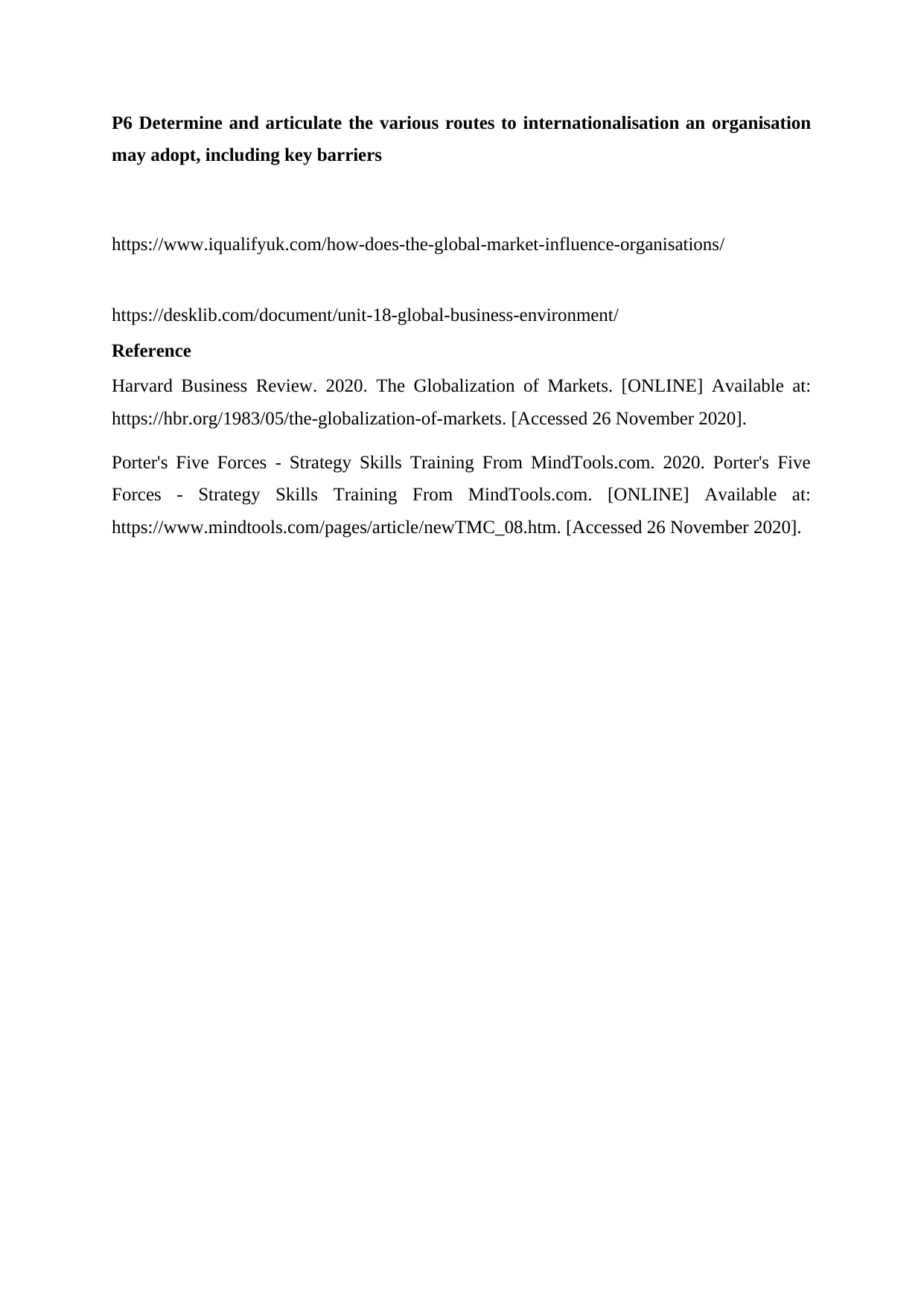
P6 Determine and articulate the various routes to internationalisation an organisation
may adopt, including key barriers
https://www.iqualifyuk.com/how-does-the-global-market-influence-organisations/
https://desklib.com/document/unit-18-global-business-environment/
Reference
Harvard Business Review. 2020. The Globalization of Markets. [ONLINE] Available at:
https://hbr.org/1983/05/the-globalization-of-markets. [Accessed 26 November 2020].
Porter's Five Forces - Strategy Skills Training From MindTools.com. 2020. Porter's Five
Forces - Strategy Skills Training From MindTools.com. [ONLINE] Available at:
https://www.mindtools.com/pages/article/newTMC_08.htm. [Accessed 26 November 2020].
may adopt, including key barriers
https://www.iqualifyuk.com/how-does-the-global-market-influence-organisations/
https://desklib.com/document/unit-18-global-business-environment/
Reference
Harvard Business Review. 2020. The Globalization of Markets. [ONLINE] Available at:
https://hbr.org/1983/05/the-globalization-of-markets. [Accessed 26 November 2020].
Porter's Five Forces - Strategy Skills Training From MindTools.com. 2020. Porter's Five
Forces - Strategy Skills Training From MindTools.com. [ONLINE] Available at:
https://www.mindtools.com/pages/article/newTMC_08.htm. [Accessed 26 November 2020].
⊘ This is a preview!⊘
Do you want full access?
Subscribe today to unlock all pages.

Trusted by 1+ million students worldwide
1 out of 6
Related Documents
Your All-in-One AI-Powered Toolkit for Academic Success.
+13062052269
info@desklib.com
Available 24*7 on WhatsApp / Email
![[object Object]](/_next/static/media/star-bottom.7253800d.svg)
Unlock your academic potential
Copyright © 2020–2025 A2Z Services. All Rights Reserved. Developed and managed by ZUCOL.




